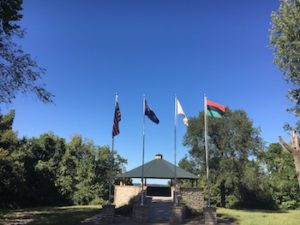
Quindaro Town site memorial
*On this date, 1857, Quindaro Townsite, KS, was founded. Quindaro was one of several competing small ports on the Missouri River and part of the conflict of American slavery’s expansion.
Quindaro was founded in the 1850s by abolitionists, settlers, the Wyandot people, and freedmen. Abelard Guthrie, credited as the founder who purchased land for the settlement, named it after his wife, Nancy Quindaro Brown Guthrie. She was a member of the Wyandot Native American tribe and had persuaded them to sell land to her husband. The Society had aided more than 1,200 settlers in their migration, hoping to secure Kansas as a free territory.
After the Kansas–Nebraska Act was passed in 1854, a western branch of the Underground Railroad was developed in Kansas. Quindaro was linked to this and the Lane Trail. It provided a new route of escape for slaves from Missouri. Construction began in January 1857, and the town soon featured numerous stone houses and the establishment of several businesses. Its sawmill was the largest in Kansas territory. The lower town site near the river was the commercial core, and most residences were higher on the bluff at the upper town site. In the first year, 100 buildings were completed, with many of stone and brick, "including hotels, Dry Goods, Hardware, and Grocery stores, a Church [two churches], and a Schoolhouse." It was most important in the years leading up to Kansas being established as a free state in 1861.
Quindaro became a legendary port for fugitive slaves and, later, Black people arriving as contraband (escapees) during the American Civil War. Even before the war ended, however, Eben Blachly, a white Presbyterian minister, 1862 started classes in his home for the Black children of former slaves. The Reverend Eben Blachly had been a farmer in Dane County, Wisconsin, one of the early pioneers who had migrated from Pennsylvania. According to Blachly's family legend, he was nearly hanged as a "northern spy" while trying to find his oldest son, a Union soldier captured by the Confederates. With the noose around his neck, he asked to say some final words, a wish granted by the rebels. After praying out loud for the welfare of their souls (the rebels were about to hang an innocent man), they took the noose off his neck and sent him home to Wisconsin.
This traumatic experience led him to dedicate his life to helping former slaves by organizing the Quindaro Freedman's School (later Western University), which was chartered in 1867 at the upper town site of Quindaro, where he served as its director until he died in 1877. John Morgan Walden was one of many young white men attracted to Quindaro, where he founded a Free-Soil paper called Quindaro Chindowan, a Wyandot word for "leader." He was also a missionary to freedmen and later became a bishop in the Methodist Church.
Clarina Nichols was a writer for the Chindowan and Underground Railroad Conductor in Quindaro. Due to economic pressures that afflicted much of Kansas, the commercial town site declined. Later-arriving Blacks settled in the upper town on the bluff. The economy declined due to over-speculation in Kansas, and in 1862, the legislature withdrew the town's charter, effectively putting the town corporation out of business. After being abandoned, the early lower commercial townsite became overgrown, with some areas covered by earth falling from the bluffs. In the early 20th century, the town site was incorporated into Kansas City, Kansas. Western University closed in 1943, and only the cornerstones of some early buildings remain.
In 1993, Kansas State University, in cooperation with the Mayor's Underground Railroad Advisory Commission and the Quindaro Town Preservation Society, commissioned graduate students to develop proposals for a park to incorporate the ruins and archaeology of Quindaro. In 1996, the University of Kansas sponsored a major oral history project. More than a dozen professors interviewed people in the nearby Black community for their family accounts of Quindaro. The history and legends of the settlement were passed down in stories told by their descendants and friends. Because of the brief life of Quindaro, it was not much documented in written records. Public history projects have identified some new sources.
It was placed on the National Register of Historic Places on May 22, 2002. In December 2007, the Kansas Humanities Council awarded a grant to the Concerned Citizens of Old Quindaro, Kansas City, for In Unity There is Strength: The African American Experience, an exhibit to interpret the history of former slaves who escaped to Quindaro from across the Missouri River in the mid-19th century. The exhibit addressed religious, educational, and business elements of the community they created. It is an archaeological district near North 27th Street and the Missouri Pacific Railroad tracks in Kansas City, Kansas.